Investigation and Analysis of the Influence of Environmental Factors on the Temperature Distribution of Thin-Walled Concrete
Abstract
:1. Introduction
2. Thin-Walled Concrete Temperature Experiments
2.1. Specimen Design
2.2. Experimental Process
3. Measured Temperature Field of Thin-Walled Concrete
3.1. Comparison of Horizontal and Vertical Temperature Fields
3.2. Seasonal Changes in Mean Vertical Temperature
3.3. Seasonal Changes in Vertical Gradient Temperature
- (1)
- is the gradient temperature pattern when the temperature difference between the top and bottom elevations is the maximum positive value within a day. For example, the gradient temperature pattern at 16:00 in Figure 6 corresponds to the largest value of 7.26 °C within a day (the difference between point a1 and point b1).
- (2)
- is the gradient temperature pattern when the temperature difference between the top and bottom elevations is the maximum negative value within a day. For example, the gradient temperature pattern at 6:00 in Figure 6 corresponds to the smallest value of −1.63 °C within a day (the difference between point a2 and point b2).
4. Environmental Impact on Temperature Distribution of Thin-Walled Concrete
4.1. Sensitivity Analysis of Thin-Walled Concrete to Environmental Factors Based on Random Forest Regression
4.2. Correlation between Temperature Distribution and Environmental Factors
4.2.1. Concrete Mean Temperature and Air Temperature
4.2.2. Concrete Gradient Temperature and Solar Radiation
5. Conclusions
- (1)
- For green and environmentally friendly resource consumption in the temperature measurement experiment, a concrete block specimen with a layer of thermal insulation material on the lateral surface was used to simulate thin-walled concrete. Furthermore, this method was verified by a result showing that the vertical temperature difference was the dominant difference in the whole temperature field.
- (2)
- Seasonally, the Tm was highest in summer and lowest in winter, while the Tm in spring had the most drastic fluctuations. Two extreme gradient temperature patterns, and , occurred in summer and winter, respectively. The in winter was −0.26 times the in summer, which is close to the AASHTO LRDF-recommended value. In addition, the and in all seasons could be expressed by an exponential function with parameters composed of the corresponding Tgb and Tgt, as well as a = 11.5.
- (3)
- Random forest regression was applied to analyze the specimen’s sensitivity to environmental factors, which found that wind speed was negligible for the thin-walled concrete temperature field. Moreover, air temperature controlled the concrete Tm, while solar radiation was the dominant factor for Tgb and Tgt.
- (4)
- Regarding the mean temperature, , , and were all linearly and positively correlated with the average air temperature and the correlation ratios (°C/°C) were, respectively, 0.97, 1.02, and 1.08, with a difference of less than 11.3%, indicating that fluctuations in the mean temperature within a day were small.
- (5)
- The patterns of gradient temperature changes were different for different elevations. For the bottom shadowed surface, and were both linearly and negatively correlated with the average solar radiation with correlation ratios (°C/kW) of −11.4 and −5.37, respectively. At the top radiated surface, both and had a positive linear correlation with the average solar radiation, and the correlation ratios (°C/kW) were 35.0 and 9.6, respectively.
Author Contributions
Funding
Institutional Review Board Statement
Informed Consent Statement
Data Availability Statement
Conflicts of Interest
References
- Yang, Y.; Mo, X.; Shi, K.; Wang, Z.-L.; Xu, H.; Wu, Y. Scanning torsional-flexural frequencies of thin-walled box girders with rough surface from vehicles’ residual contact response: Theoretical study. Thin-Walled Struct. 2021, 169, 108332. [Google Scholar] [CrossRef]
- Reichenbach, S.; Kollegger, J. Detailed Study of Bridges out of Thin Walled Precast Concrete Elements. Procedia Eng. 2016, 156, 388–394. [Google Scholar] [CrossRef]
- Lu, Z.; Feng, Z.-G.; Yao, D.; Li, X.; Jiao, X.; Zheng, K. Bonding performance between ultra-high performance concrete and asphalt pavement layer. Constr. Build. Mater. 2021, 312, 125375. [Google Scholar] [CrossRef]
- Baleshan, B.; Mahendran, M. Fire design rules to predict the moment capacities of thin-walled floor joists subject to non-uniform temperature distributions. Thin-Walled Struct. 2016, 105, 29–43. [Google Scholar] [CrossRef]
- Dang, X.B.; Wan, M.; Zhang, W.-H.; Yang, Y. Stability analysis of the milling process of the thin floor structures. Mech. Syst. Signal Process. 2021, 165, 108311. [Google Scholar] [CrossRef]
- Chu, Y.; Hou, H.; Yao, Y. Experimental study on shear performance of composite cold-formed ultra-thin-walled steel shear wall. J. Constr. Steel Res. 2020, 172, 106168. [Google Scholar] [CrossRef]
- Zingoni, A.; Mudenda, K.; French, V.; Mokhothu, B. Buckling strength of thin-shell concrete arch dams. Thin-Walled Struct. 2013, 64, 94–102. [Google Scholar] [CrossRef]
- Wei, P.; Lin, P.; Peng, H.; Yang, Z.; Qiao, Y. Analysis of cracking mechanism of concrete galleries in a super high arch dam. Eng. Struct. 2021, 248, 113227. [Google Scholar] [CrossRef]
- Xiao, J.L.; Yang, Y.; Zhuang, L.D.; Nie, X. A numerical and theoretical analysis of the structural performance for a new type of steel-concrete composite aqueduct. Eng. Struct. 2021, 245, 112839. [Google Scholar] [CrossRef]
- Liu, Y.; Dang, K.; Dong, J. Finite element analysis of the seismicity of a large aqueduct. Soil Dyn. Earthq. Eng. 2017, 94, 102–108. [Google Scholar] [CrossRef]
- Zhou, W.; Zhang, Z.; Qin, P.; Tian, B.; Zhang, X. Cause analysis of cracks in dual arch dam of Huojia. Jiangxi Hydraul. Sci. Technol. 2023, 49, 50–56. [Google Scholar] [CrossRef]
- Gu, P.; Wang, L.; Deng, C.; Tang, L. Review of typical failure characteristics of aqueduct structures in China. Adv. Sci. Technol. Water Resour. 2017, 37, 1–8. [Google Scholar] [CrossRef]
- Li, Y.; Nie, L.; Wang, B. A numerical simulation of the temperature cracking propagation process when pouring mass concrete. Autom. Constr. 2014, 37, 203–210. [Google Scholar] [CrossRef]
- Chen, B. Research on the Internal Thermal Boundary Conditions of Concrete Closed Girder Cross-Sections under Historically Extreme Temperature Conditions. Appl. Sci. 2020, 10, 1274. [Google Scholar] [CrossRef]
- Zhou, Y.; Bai, L.; Yang, S.; Chen, G. Simulation Analysis of Mass Concrete Temperature Field. Procedia Earth Planet. Sci. 2012, 5, 5–12. [Google Scholar] [CrossRef]
- Zhang, C.; Liu, Y.; Liu, J.; Yuan, Z.; Zhang, G.; Ma, Z. Validation of long-term temperature simulations in a steel-concrete composite girder. Structures 2020, 27, 1962–1976. [Google Scholar] [CrossRef]
- Lu, Y.; Li, D.; Wang, K.; Jia, S. Study on Solar Radiation and the Extreme Thermal Effect on Concrete Box Girder Bridges. Appl. Sci. 2021, 11, 6332. [Google Scholar] [CrossRef]
- Fan, J.S.; Liu, Y.F.; Liu, C. Experiment study and refined modeling of temperature field of steel-concrete composite beam bridges. Eng. Struct. 2021, 240, 112350. [Google Scholar] [CrossRef]
- Liu, C.; Xiao, J.; Ma, K.; Xu, H.; Shen, R.; Zhang, H. Experimental and numerical investigation on the temperature field and effects of a large-span gymnasium under solar radiation. Appl. Therm. Eng. 2023, 225, 120169. [Google Scholar] [CrossRef]
- Wang, Y.; Zhu, J.; Guo, Y.; Wang, C. Early shrinkage experiment of concrete and the development law of its temperature and humidity field in natural environment. J. Build. Eng. 2023, 63, 105528. [Google Scholar] [CrossRef]
- Larsson, O.; Thelandersson, S. Estimating extreme values of thermal gradients in concrete structures. Mater. Struct. 2011, 44, 1491–1500. [Google Scholar] [CrossRef]
- Liu, P.; Yu, Z.; Guo, F.; Chen, Y.; Sun, P. Temperature response in concrete under natural environment. Constr. Build. Mater. 2015, 98, 713–721. [Google Scholar] [CrossRef]
- Liu, J.; Liu, Y.; Jiang, L.; Zhang, N. Long-term field test of temperature gradients on the composite girder of a long-span cable-stayed bridge. Adv. Struct. Eng. 2019, 22, 2785–2798. [Google Scholar] [CrossRef]
- Liu, J.; Liu, Y.; Zhang, G. Experimental Analysis of Temperature Gradient Patterns of Concrete-Filled Steel Tubular Members. J. Bridge Eng. 2019, 24, 04019109. [Google Scholar] [CrossRef]
- JTG D60-2015; General Specifications for Design of Highway Bridges and Culverts. China Communications Press: Beijing, China, 2015.
- Shafigh, P.; Asadi, I.; Mahyuddin, N.B. Concrete as a thermal mass material for building applications—A review. J. Build. Eng. 2018, 19, 14–25. [Google Scholar] [CrossRef]
- Asadi, I.; Shafigh, P.; Hassan, Z.F.A.B.; Mahyuddin, N.B. Thermal conductivity of concrete—A review. J. Build. Eng. 2018, 20, 81–93. [Google Scholar] [CrossRef]
- AASHTO. LRFD Bridge Design Specifications, 8th ed.; AASHTO: Washington, DC, USA, 2017. [Google Scholar]
- Antoniadis, A.; Lambert-Lacroix, S.; Poggi, J.M. Random forests for global sensitivity analysis: A selective review. Reliab. Eng. Syst. Saf. 2021, 206, 107312. [Google Scholar] [CrossRef]
- Auret, L.; Aldrich, C. Empirical comparison of tree ensemble variable importance measures. Chemom. Intell. Lab. Syst. 2011, 105, 157–170. [Google Scholar] [CrossRef]
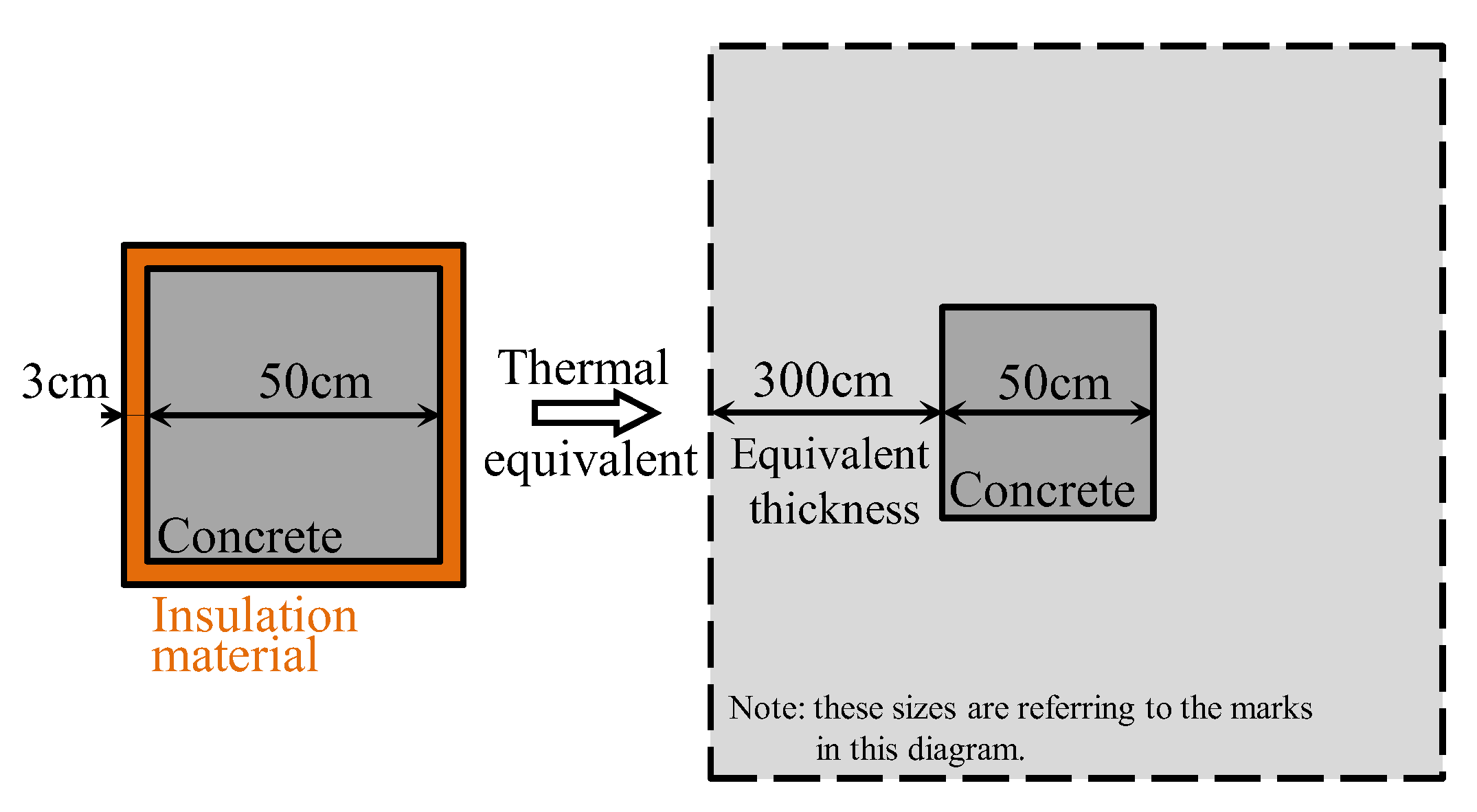
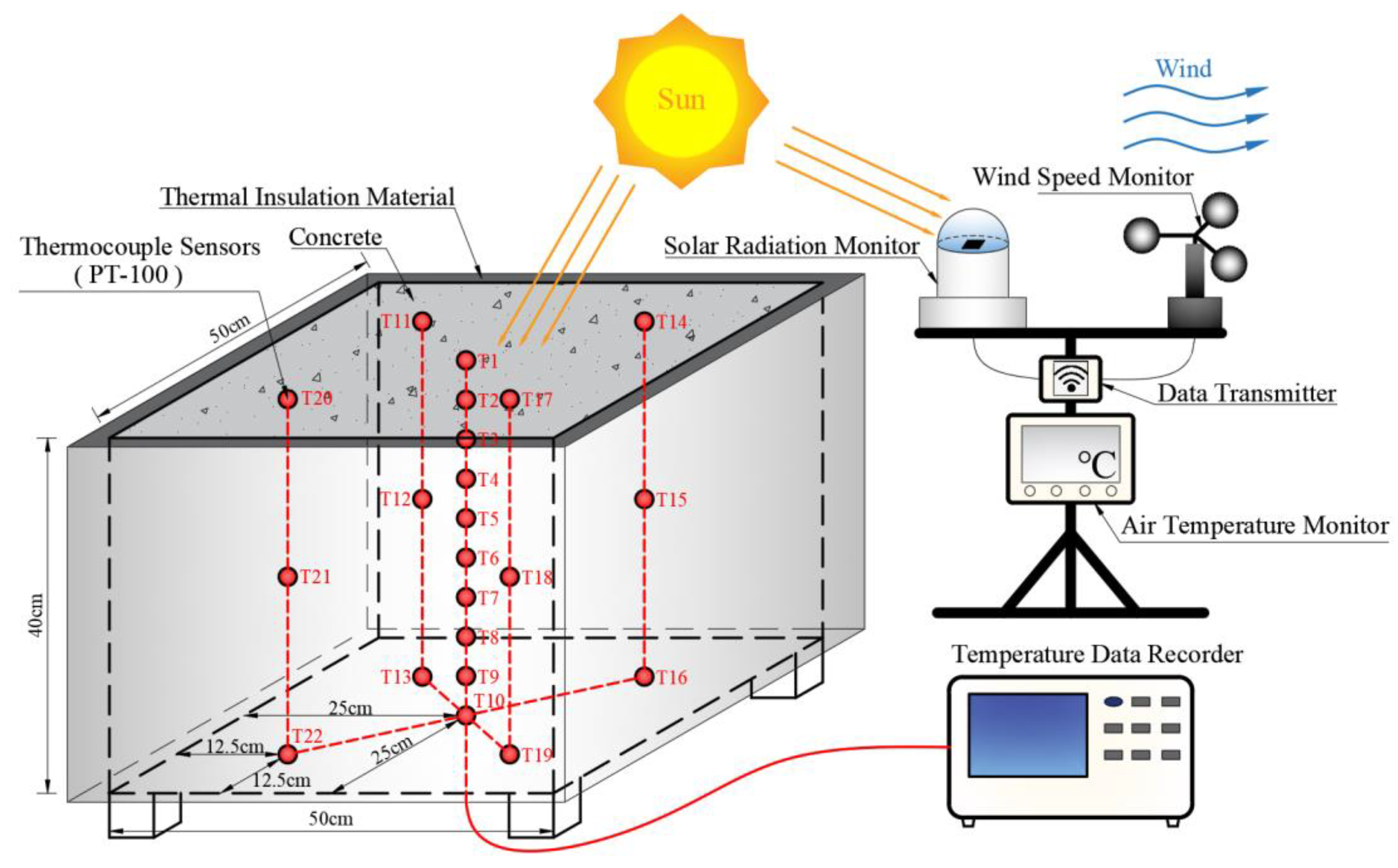



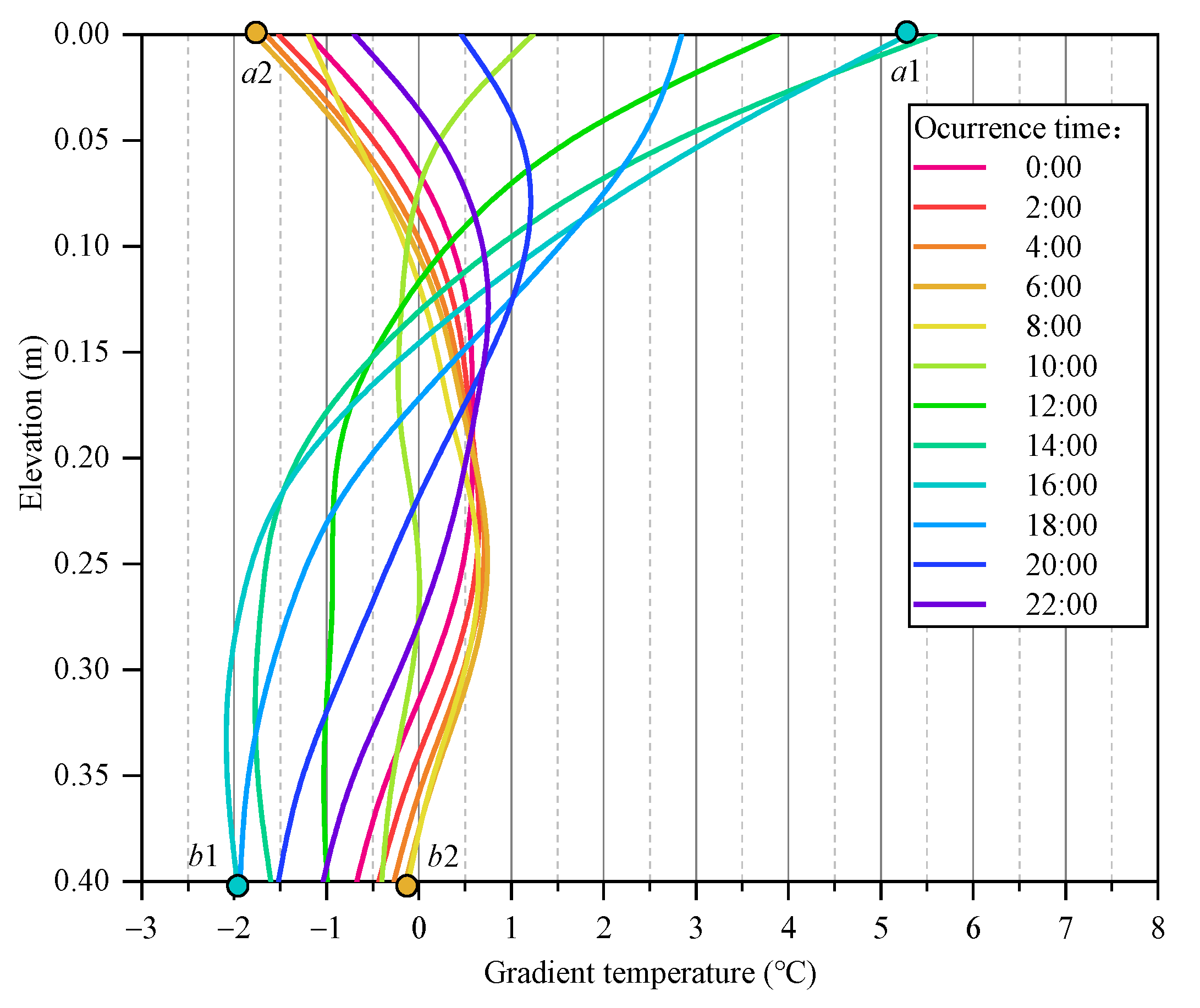

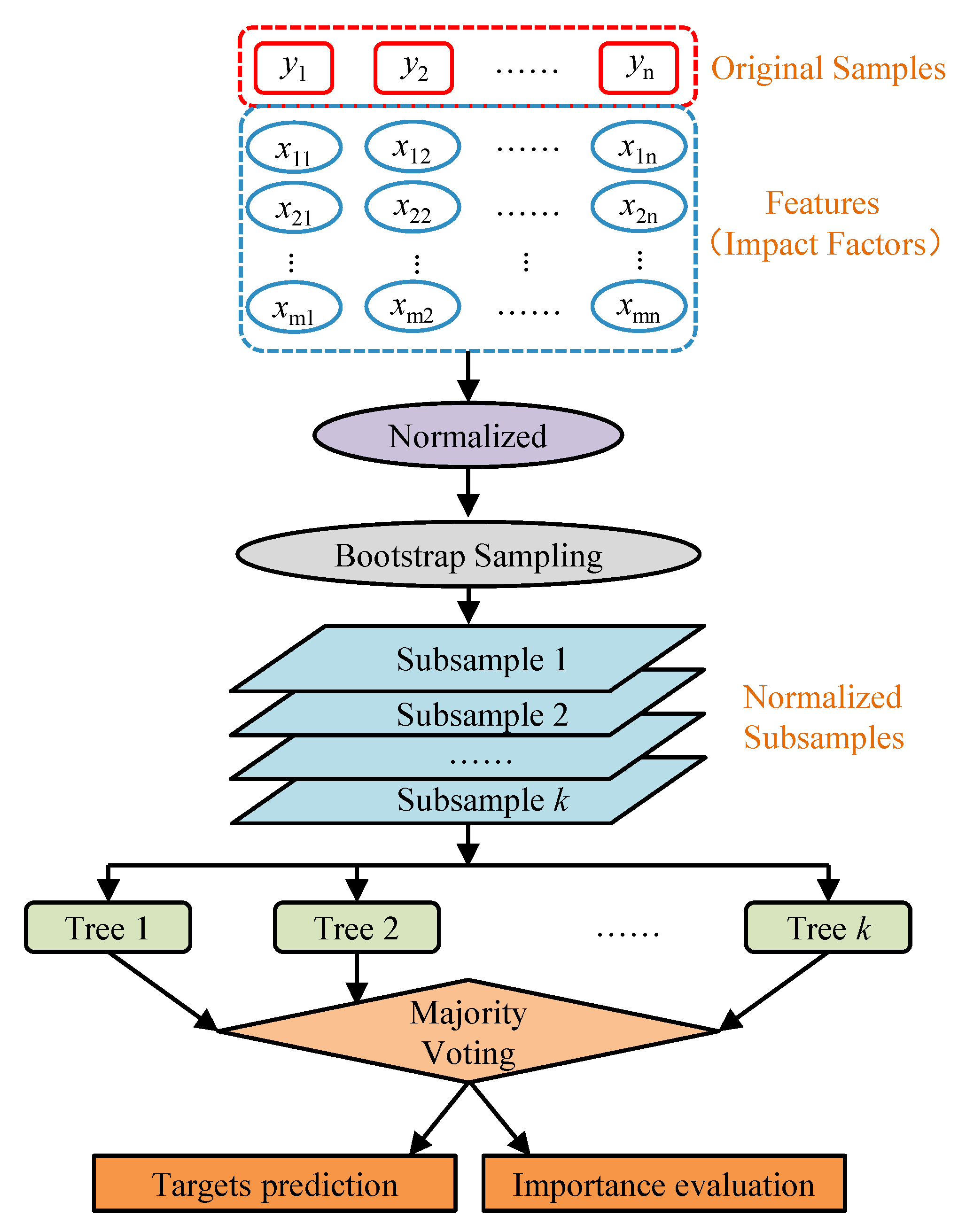
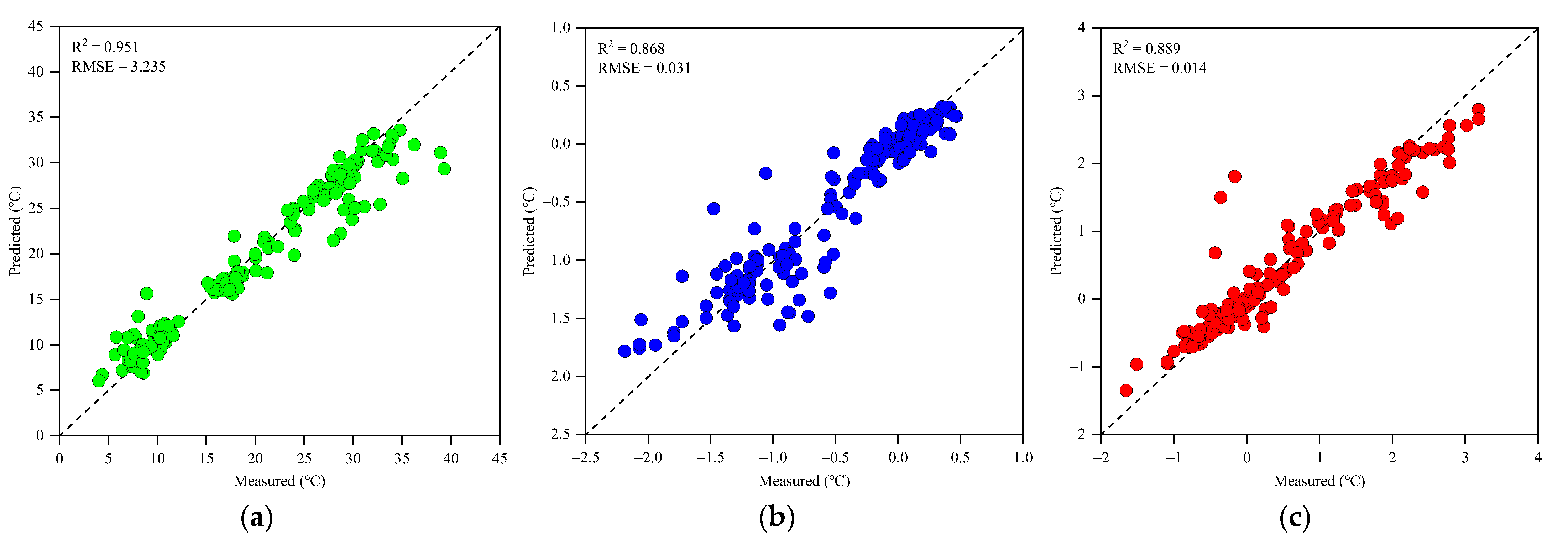
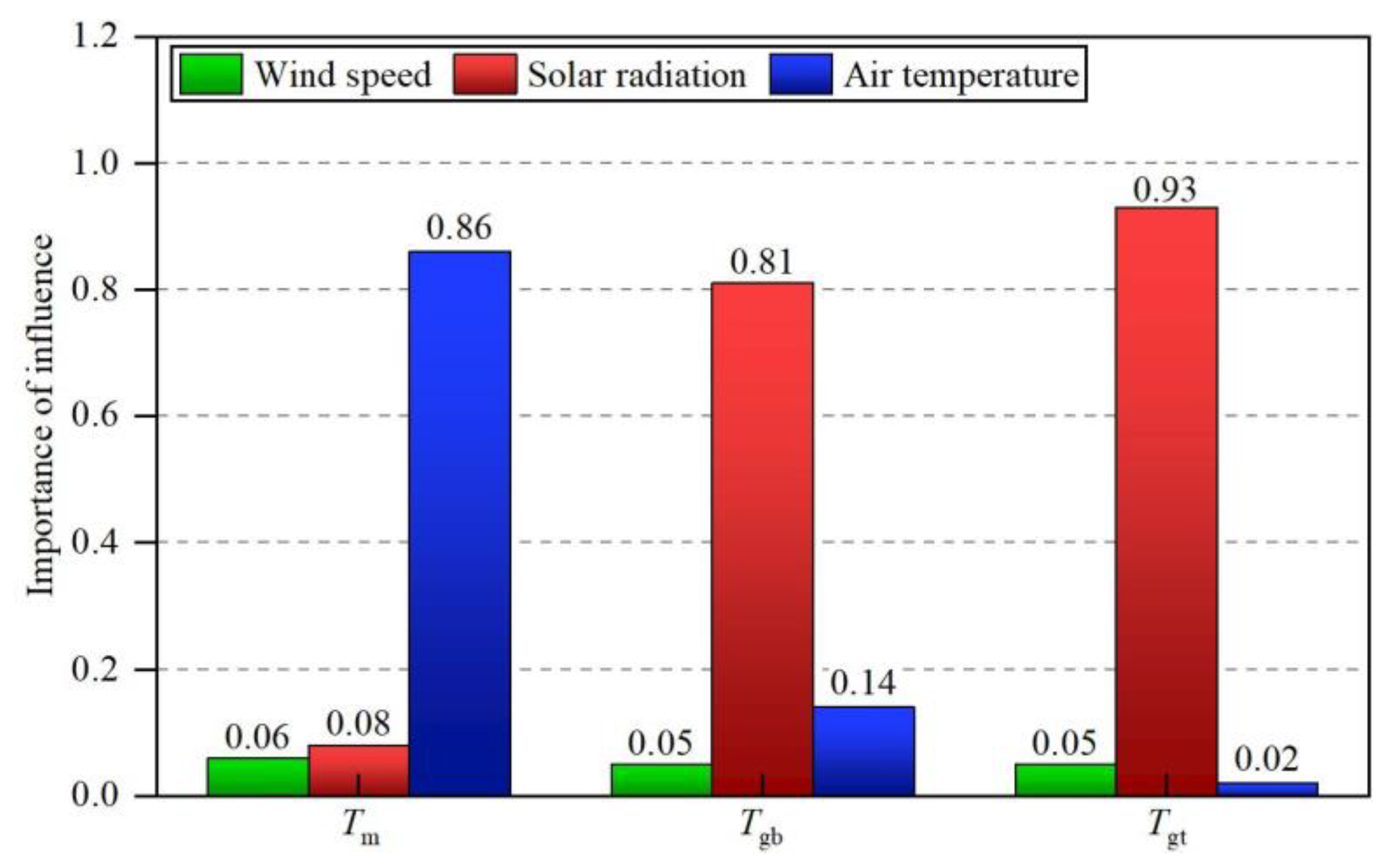
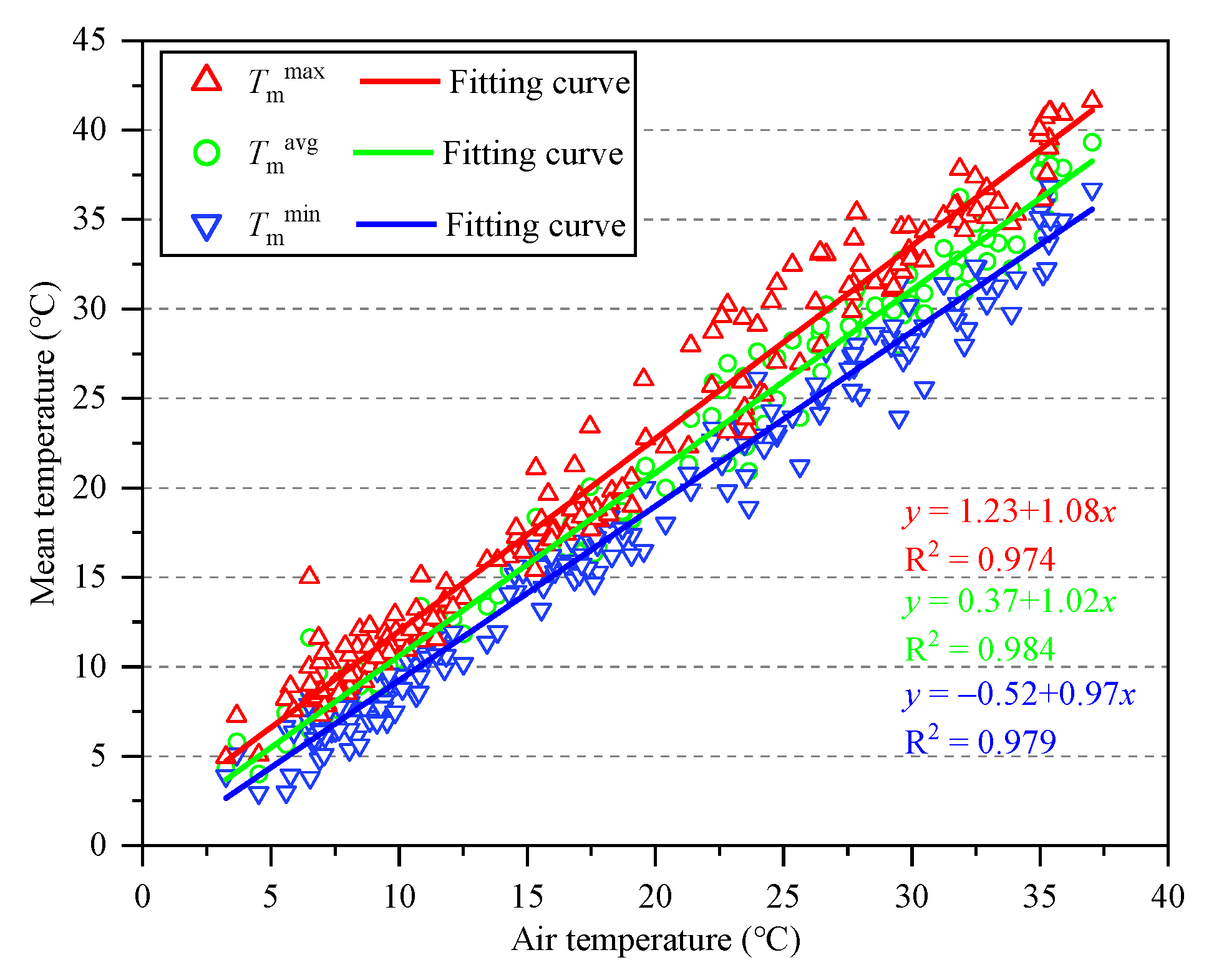
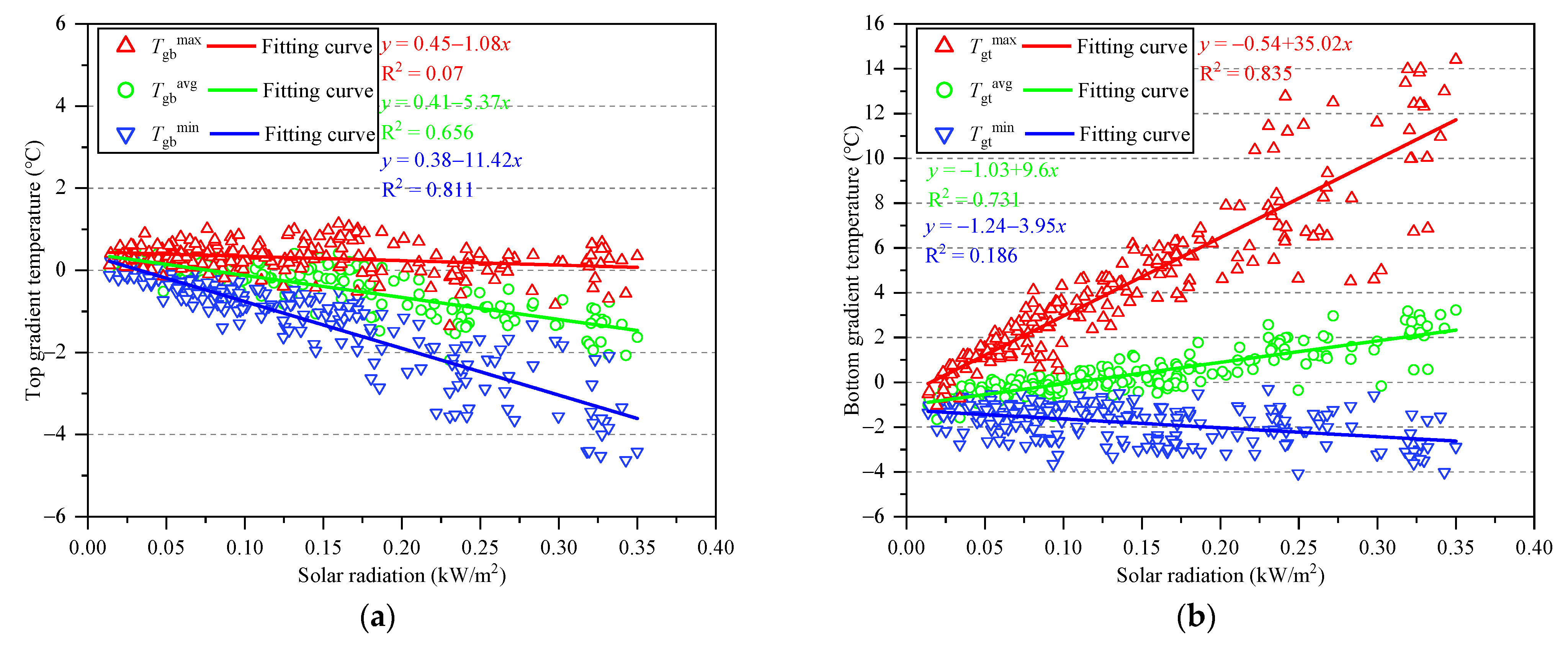
| Water–Cement Ratio | Aggregate–Cement Ratio | Sand Ratio | Material Usage/(kg·m−3) | ||||
|---|---|---|---|---|---|---|---|
| Water | Cement | Fine Aggregate | Coarse Aggregate | Fly Ash | |||
| 0.31 | 3.78 | 39% | 166 | 477 | 703.25 | 1101.75 | 52 |
| Pattern | Parameter | Spring | Summer | Autumn | Winter |
|---|---|---|---|---|---|
| m | −1.64 | −1.84 | −1.00 | −0.37 | |
| n | 6.68 | 7.50 | 4.62 | 2.98 | |
| m | 0.02 | −0.20 | 0.23 | 0.45 | |
| n | −1.29 | −1.51 | −1.83 | −2.02 |
Disclaimer/Publisher’s Note: The statements, opinions and data contained in all publications are solely those of the individual author(s) and contributor(s) and not of MDPI and/or the editor(s). MDPI and/or the editor(s) disclaim responsibility for any injury to people or property resulting from any ideas, methods, instructions or products referred to in the content. |
© 2023 by the authors. Licensee MDPI, Basel, Switzerland. This article is an open access article distributed under the terms and conditions of the Creative Commons Attribution (CC BY) license (https://creativecommons.org/licenses/by/4.0/).
Share and Cite
Yang, W.; Pang, M.; Xie, H.; Xiao, M.; Pei, J.; Zhuo, L. Investigation and Analysis of the Influence of Environmental Factors on the Temperature Distribution of Thin-Walled Concrete. Appl. Sci. 2023, 13, 12157. https://doi.org/10.3390/app132212157
Yang W, Pang M, Xie H, Xiao M, Pei J, Zhuo L. Investigation and Analysis of the Influence of Environmental Factors on the Temperature Distribution of Thin-Walled Concrete. Applied Sciences. 2023; 13(22):12157. https://doi.org/10.3390/app132212157
Chicago/Turabian StyleYang, Wenjian, Mingliang Pang, Hongqiang Xie, Mingli Xiao, Jianliang Pei, and Li Zhuo. 2023. "Investigation and Analysis of the Influence of Environmental Factors on the Temperature Distribution of Thin-Walled Concrete" Applied Sciences 13, no. 22: 12157. https://doi.org/10.3390/app132212157
APA StyleYang, W., Pang, M., Xie, H., Xiao, M., Pei, J., & Zhuo, L. (2023). Investigation and Analysis of the Influence of Environmental Factors on the Temperature Distribution of Thin-Walled Concrete. Applied Sciences, 13(22), 12157. https://doi.org/10.3390/app132212157






